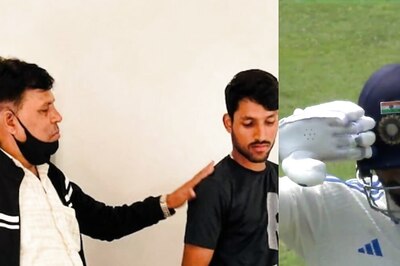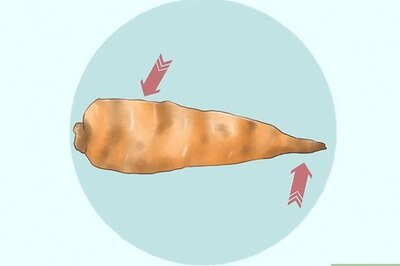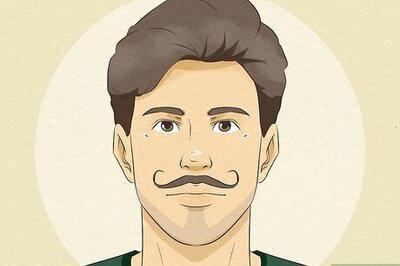
views
What are lesbian hands?
“Lesbian hands” is an LGBTQ+ joke about how lesbians have distinct hands. The term has recently become a popular inside joke on TikTok and other social media, with lesbian users displaying their hands for the camera or comparing their hands to their straight friends’ hands. It’s mostly just for laughs, but many users say that there are some classic traits of lesbians’ hands that they’ve noticed. Of course, it’s chill for lesbians to joke about lesbian topics, but keep in mind that these kinds of jokes coming from others could be seen as stereotyping or even homophobic.
Signs of Lesbian Hands
Some say lesbian hands might be more masculine. What does “masculine” mean? Tricky question. Without stereotyping or falling into problematic discussions of gender, many users say masculine lesbian hands are larger, veinier, with bonier knuckles and a boxier shape than “straight women’s hands.” These might be the hands of lesbian who identifies as “butch,” or more masculine. That said, just because someone has “masculine hands” does not make them a lesbian, and you probably shouldn’t point it out.
Other lesbian hands may be very feminine. This is where the gender dynamics of lesbians come into play. Some users say that lesbian hands may be especially feminine: slender fingers, long and painted nails, and maybe even some makeup. These sorts of lesbian hands could be described as “femme,” which is a word that describes more traditionally-feminine partners in lesbian relationships. Recently, users have been saying that two glittery nails is also a lesbian hand sign.
Lesbian hands may often have short nails. Often, lesbians keep their nails short, rather than growing them out or wearing press-ons or acrylics. And if they do have long nails, they might keep a couple nails short. We won’t mince words: it’s a sex thing. After all, long nails and sensitive private parts don’t exactly mix.
Lesbian hands might be decorated with multiple rings and tattoos. These are two more common “signs” people mention online. Tattoos and multiple rings are counter-culture coded, and some might see them as low-key signals that someone is different, no-straight, capital-L lesbian. It goes without saying that hand tattoos and rings do not a lesbian make, though, so don’t go asking the first woman with a hand tattoo if she’s lesbian. Other “lesbian” accessories include chunky watches, chains, or more gender-neutral nail polish colors.
Are lesbian hands actually a thing?
Sort of, but it’s mostly a joke. No, you can’t tell if someone is a lesbian by their hands alone. In fact, you can’t tell unless they tell you straight-up (no pun intended) that they’re a lesbian. For the most part, “lesbian hands” is an in-joke for lesbians and by lesbians that plays off of decades-old stereotypes and superstitions. Some people do take it semi-seriously, though, and there may be a kernel of truth to some signs, especially the short nail thing, even if not everyone with short nails is a lesbian. Heck, even if you see them kissing another woman, they might prefer a label like “bisexual,” or that person they’re kissing may not even identify as a woman. You can’t know unless they tell you!
Can you tell if someone is a lesbian from their appearance?
No, looks alone aren’t enough to tell if someone is lesbian. You’ll probably hear about a laundry list of supposedly “lesbian” traits: short hair, button-up shirts, Converse shoes, a ring of keys or a carabiner, etc. While some of these things are, like “lesbian hands,” in-group signs, none of them are foolproof ways to tell if someone is a lesbian. The only surefire way to tell is if they tell you themself. Plenty of straight women might wear these things or look the part, but that doesn’t mean they’re lesbian! Fashion and trends come and go, and sometimes, what people think of as “gay” might just be in style, or completely accidental.
Finding Out If Someone Is Lesbian
Ask them politely. When in doubt, you can always just ask! “It is always better to ask than to make assumptions!” says licensed clinical psychologist Kateri Berasi, PsyD. It’s best to do this in private, where other people can’t hear you, so you don’t risk outing them. Sure, they might not be a lesbian, but if they’re a cool and accepting person, they won’t be offended, either. And if they are offended about being mistaken for a lesbian, they’ve got some issues to work through. For example, say, “Hey, I was just wondering, what’s your orientation?” or, “You don’t have to answer, but I wanted to ask if you’re gay? I just want to be sure I’m not mixing up my signals!” EXPERT TIP Kateri Berasi, PsyD Kateri Berasi, PsyD Licensed Clinical Psychologist Dr. Kateri Berasi is a Licensed Clinical Psychologist and the Founder of Transcendent Self, PLLC, a group therapy practice offering affirmative, collaborative, and intentional care, based in Brooklyn, New York. With over ten years of experience in the mental health field, Dr. Berasi specializes in working with adults from the LGBTQIA+ community and creative industries through individual therapy, couples counseling, group therapy, and costume therapy. She holds a BA in Psychology, Art History, and French Language and Literature from George Washington University and an MA and MEd in Mental Health Counseling from Columbia University. Dr. Berasi also holds a PsyD in Clinical Psychology from Long Island University. Kateri Berasi, PsyD Kateri Berasi, PsyD Licensed Clinical Psychologist Make sure you have good intentions before asking about someone's sexuality. Before talking with someone about their sexuality, ask yourself why you want to know this, and why it matters to you. Are you coming from an open or judgmental place?
Ask their friends. If you have reservations about asking them directly or want to be more discreet, consider asking their friends, instead. Make your intentions clear, and don’t pressure their friends to “out” them. Keep it casual and low-key, and accept whatever answer you get. Their friends might not feel comfortable sharing that information. For example, say, “Do you know if Cassandra is gay?” or, “Don’t feel like you have to answer, but is Cassandra gay? Do you think she would be cool if I asked her directly?”
Listen for how they talk about their relationships. When someone is gay, they’ll probably use words like “my partner” or even “my girlfriend.” Or, they might talk about exes who are women, or complain about the dating pool of women, things like that. You might be able to pick up some valuable clues this way! You might also mention your “lesbian friend” and see how they react to the L-word, but this isn’t always the best tell.


















Comments
0 comment